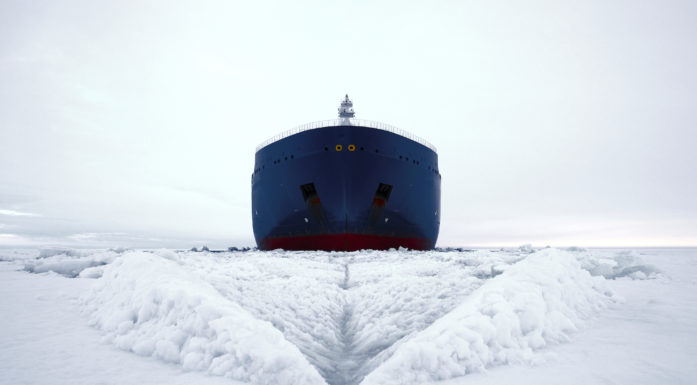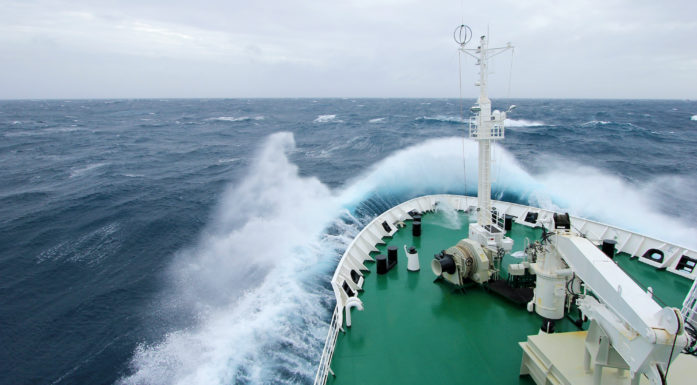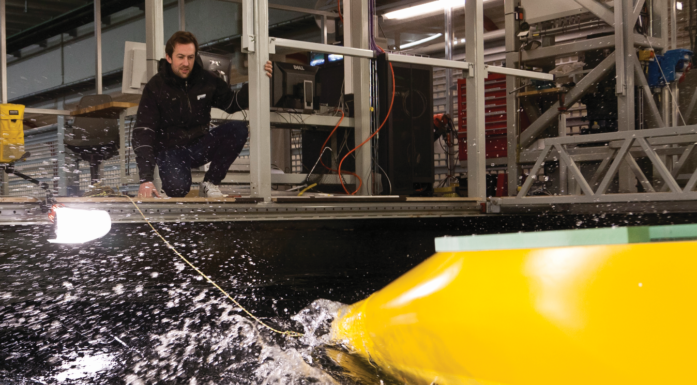The jewel in the crown
“Dynamic positioning” has been hailed as “the jewel in the crown” and Norway’s greatest engineering feat since World War II. But what is it?
MARITIME TECHNOLOGY: Dynamic positioning does not sound particularly exciting to the uninitiated, but it has helped bring huge revenues to Norway. And a Norwegian company is the world leader in the field.
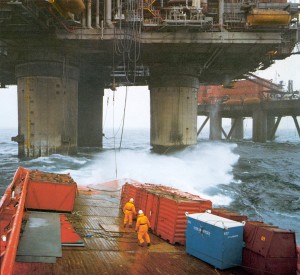
Dynamic positioning enables platforms and ships to hold their position in the sea without any anchor or line. (Photo: Statoil)
Readers of Norway’s Technical Weekly Magazine recently named dynamic positioning, a technology from Kongsberg Maritime, as the greatest engineering feat in Norway since the war.
Dynamic positioning, or DP, is a computer-controlled system that uses the platform’s or ship’s propellers and thrusters to automatically maintain the vessel’s position. This is crucial for oil and gas extraction in deep water.
You can’t just throw out an anchor near a drilling platform, with so much vulnerable technology on the seabed. Nor can you have ships colliding with platforms or each other. And several operations on board the ships and platforms require them to be absolutely stable.
Associate Professor Stig Kvaal and fellow Professor Per Østby at NTNU have written the newly published book Juvelen i kronen [The Jewel in the Crown], which presents the development of Kongsberg Maritime’s dynamic positioning systems.
Kvaal and Østby work at NTNU’s Department of Interdisciplinary Studies of Culture. The book’s title plays on the crown in the logo of Kongsberg Gruppen.
According to Kvaal, the Norwegian system was developed by a “creative and dynamic group” at the Kongsberg Weapons Factory and the Norwegian Institute of Technology (NTH) in Trondheim. It all started quietly.
An NTH brainstorm
The original idea came from NTNU’s main predecessor, NTH, where Professor Jens Glad Balchen had an idea that he wanted to turn into a business.
“The idea started here, and the theoretical groundwork was done here,” says Østby.
In 1971, Balchen contacted the management at the Kongsberg Weapons Factory (KV). He suggested that KV develop a dynamic positioning system, since the company had experience with other automated systems.
KV’s management said no. Balchen came back a little later, and KV said no again.
Slow start
But Balchen persisted. He knew DP systems already existed, although they were not so well suited for the North Sea. The Americans had used them for ten years. Now he proposed to build a better system in Norway.
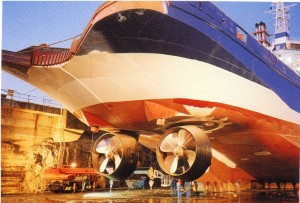
Azimuth thrusters on the icebreaker Fennica help to keep the ship in position. (Photo: Kongsberg Maritime)
He knew that new advances in cybernetics could be applied, especially the Kalman filter, a more accurate calculation method based on Rudolf E. Kalman’s theories. So why couldn’t KV join in to create their own systems? With offshore oil extraction imminent, this technology would be needed.
Balchen had long worked closely with SINTEF, an independent research organization in Norway. In the 1950s he had also helped expand the cybernetics programme at NTH.
KV only became interested in 1973, after Balchen contacted a third time.
Oil
The need for new technology was certainly there. Huge platforms were placed in the North Sea to bring up the oil that would someday make Norway rich. Much of the early work was carried out in relatively shallow waters where it was possible to anchor. Many of the first platforms rested on the seabed.
Divers did a lot of the rough work, and operated from diving vessels. This job was already dangerous, and became more so as the oil industry moved out to deeper waters. Eventually, the demand grew for ships and other structures that could remain stable while they floated.
KV was state owned, and in the 1970s it was a development workshop for technology concepts from Norwegian research institutes such as the Norwegian Defence Research Establishment (FFI) and SINTEF. When oil was discovered in the North Sea, KV saw new opportunities.
The albatross flies
In the course of eighteen months, Kongsberg Weapons Factory, Simrad, the Chr. Michelsen Institute (CMI) and NTH/SINTEF developed a Norwegian DP system called ADP-500.
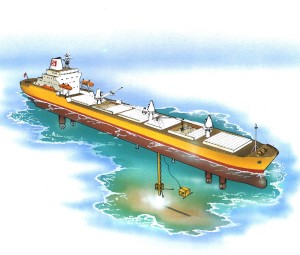
Seaway Sandpiper was the first ship with auto-track functionality, which could follow a pipeline in a straight line between two geographical points. (Illustration: Kongsberg Maritime)
For researchers at NTNU and SINTEF, that meant a new possible application for cybernetic principles.
The timing was good. There was a lot of money in the oil sector. Norway had the right professionals. And yet things weren’t working out. They weren’t finding buyers for the system.
“There was talk of stopping the project already in November 1975. Then ship-owner Jacob Stolt-Nielsen ordered the first system,” Østby says.
Stolt-Nielsen Seaways had a rig they were not having any luck renting out, and so they decided to convert it from a drilling rig to a service vessel. They believed DP could give them a competitive advantage. The order came just in time.
The DP systems constructed by Dynposprosjektet, which later became Albatross Industries, were developed in a short period of time.
Forgiveness, not permission
The new DP system was created by people who tended to ask for forgiveness rather than permission.
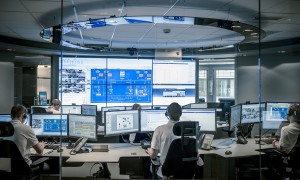
This photos shows Kongsberg Gruppen’s call centre in Kongsberg, one of three. The other two are in Singapore and New Orleans, so that customers can connect with real people at any time of night or day. (Photo: Kongsberg Maritime)
They were the developers who knew they were capable of achieving anything.
But they were also the salespeople who would come back with contracts for systems that no one had seen, much yet developed, yet. The developers then had to show that they were able to deliver. Quite a few people were getting far less than the recommended hours of sleep.
Kvaal and Østby concur that “the culture was special — it was a bit like the Silicon Valley in the United States that we have today.”
“A dose of madness” is one of the phrases they use to describe the environment. But at the same time, these were people who were willing to head out immediately when a customer needed help.
One of the slogans was “We live for, with and from our customers.” Company staff were always available if a customer was in trouble, a critical factor for large companies who lose big sums of money whenever a ship or rig is out of commission.
Roar Flaathen, KV’s union representative who later became the leader of the Norwegian Confederation of Trade Unions (LO), complained that people took unheard of liberties in the KV system.
But Rolf Qvenild, chief executive of KV, let them continue. They were generating income. As long as you deliver the goods, you can allow yourself some idiosyncrasies.
Ups and downs
Myth would have it that development and testing of the Norwegian system were completed on 17 May 1977. Norway’s Constitution Day is a nifty date, but in reality it was tested and developed both before and afterwards.
Dynamic positioning
- A dynamically positioned (or DP) vessel can maintain a fixed position relative to the seabed. Advanced technology, various types of position sensors, propellers and thrusters enable it to counteract natural forces such as wind, currents and waves without the use of anchors or lines.
- Modern offshore industry would be inconceivable without dynamic positioning. DP is an "enabling technology” and relates especially to the development and operation of offshore oil and gas fields.
- Dynamic positioning systems from Kongsberg are now found aboard supply ships, drilling rigs, pipe- and cable laying ships, rock dumping vessels, shuttle tankers, crane vessels, marine hunting vessels, cruise ships, floating hotels and yachts. They no longer just lie at rest, but can equally well follow a route or stay within a larger defined area.
- A modern DP-operated drilling rig typically generates the power equivalent of a medium-sized Norwegian hydropower plant, or is equivalent to the consumption of about 15,000 people.
- It has been 40 years since Kongsberg got its first contract for a DP control system with ship owner Stolt-Nielsen.
KV expanded into more fields. Albatross AS eventually spun off as a separate company. KV has been the world leader in dynamic positioning since 1980.
Large parts of the market disappeared with the drop in oil prices in 1987. KV was technically bankrupt, and Albatross was sold to Simrad in Horten, south of Oslo. However, the company stayed in Kongsberg throughout. Kongsberg Gruppen (KOG) was established from the “remnants” of the old weapons factory, and in 1996 KOG acquired Simrad. The DP enterprise now belongs to Kongsberg Maritime, which is part of KOG.
World leader
Kongsberg’s positioning system is the world leader in the field, holding approximately 80 per cent market share in the high-end market — not bad for a business in an inland municipality without any coastline.
Part of the secret is still service, and the willingness to be available for the customer at any time of day or night. Kongsberg Maritime has offices in several locations around the world, so someone always responds when a customer needs follow-up.
The system has also become a market standard of sorts that competing technologies have to deal with.
Kongsberg Gruppen has earned good money on the system, which has also been key to extracting the oil riches in the North Sea.
In other words, KOG’s dynamic positioning systems have come about through “a dynamic combination of engineering skills and sales talent, and the ability to not only help customers keep their vessels in position, but also to position themselves well,” according to the book’s authors.

